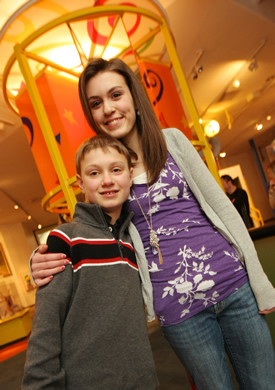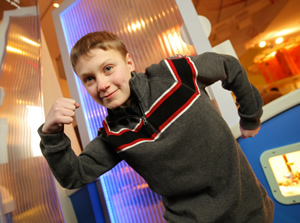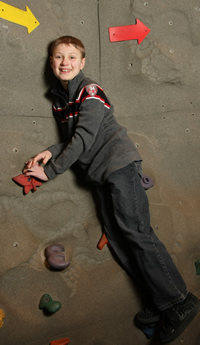Miracle Kids: Connor Tillapaugh
Teen Survives and Thrives after Rare Brain Disorder Threatens His Life
 When Connor Tillapaugh was 9, his teacher at Lima Christian School, Beth Long, told his parents she was concerned about him. Connor was having some staring episodes and trouble paying attention in school. Long encouraged Connor’s parents to take him to see his pediatrician, Janet Casey, M.D., clinical associate professor of Pediatrics at the University of Rochester Medical Center (URMC). After an abnormal EEG test in the fall of 2005, Casey referred Connor to Jonathan Mink, M.D, chief of Child Neurology at Golisano Children’s Hospital at URMC, for further testing.
When Connor Tillapaugh was 9, his teacher at Lima Christian School, Beth Long, told his parents she was concerned about him. Connor was having some staring episodes and trouble paying attention in school. Long encouraged Connor’s parents to take him to see his pediatrician, Janet Casey, M.D., clinical associate professor of Pediatrics at the University of Rochester Medical Center (URMC). After an abnormal EEG test in the fall of 2005, Casey referred Connor to Jonathan Mink, M.D, chief of Child Neurology at Golisano Children’s Hospital at URMC, for further testing.
During a routine neurology exam, Lisa Augostini, P.N.P., conducted a simple neurological test called the Bebinski sign, which involves scratching the sole of the foot and noting the big toe’s reflex reaction, she noticed something was wrong. Typically, the central nervous system responds with the big toe pointing down, but Connor’s toe pointed up.
Mink suspected he knew what Connor had, but wanted to run a few additional tests to confirm the diagnosis. The results from Connor’s MRI showed a white matter abnormality and a blood test confirmed Mink’s suspicion: Connor had a rare brain disorder called X-linked adrenoleukodystrophy (X-ALD).
Because of a defective gene on the X-chromosome, patients with X-ALD lack a specific enzyme that is important for breaking down very long-chain fatty acids. Very long-chain fatty acids can be found in many foods in a regular diet, such as lard and butter. These chains of acids don’t usually cause any problems if enzymes are properly breaking them down. But in patients with ALD, who don’t have that enzyme, the very long-chain fatty acids will build up and progressively damage the brain and adrenal gland, causing debilitation and eventual death, in just a few short years.
Mink knew that a bone marrow transplant was the best option for Connor, but just to be sure, he reached out to colleagues at John Hopkins University and the University of Minnesota – two of best ALD research institutions in the country. Both sets of colleagues agreed that a bone marrow transplant was Connor’s best chance at halting the rapid progression of this life-threatening disorder.
Since enzymes in the white blood cells were failing to break down the long-chain fatty acids, a bone marrow transplant would give Connor new cells from a donor in place of the defective cells. If his body accepted the new cells, those cells could provide the needed enzyme to break down long-chain fatty acids and prevent them from damaging the brain.
A popular 1992 movie Lorenzo’s Oil highlighted a special type of oil, which was developed to reduce the levels of very long-chain fatty acids and prolong degeneration of the peripheral and central nervous systems. The diet, however, wouldn’t have been useful in Connor’s situation, because it can only be helpful for patients before they show any symptoms of the disease. The diet also lacks substantial long-term results, according to Mink.
Mink wanted the family to consider all of Conner’s options, so he suggested the Tillapaughs get a consult from ALD experts at the University of Minnesota. Mink also invited them to consider having Connor’s bone marrow transplant there. He told them that Golisano Children’s Hospital was an excellent center for performing pediatric bone marrow transplants, should they choose to stay in Rochester for treatment.
“We decided we trusted the people at Strong because while they may not have been experts in this disease, we knew they were more than capable of doing transplant,” said Michelle.
Michelle and her husband David had five young children, which was another big consideration when they were deciding where Connor should have his transplant. They didn’t want to split up the family, potentially for several months, while sending one parent to stay with Connor out of town and leaving the other with the family’s four other children –Rebecca, Rachel, Jessica and Amanda – whose ages ranged from 2 to 10. In Rochester, however, the family had each other for support, a familiar environment to heal in and providers they already knew.
Mink assured the family he would keep in close touch with the experts at the University of Minnesota and he referred them to Craig Mullen, M.D., chief of Pediatric Hematology and Oncology at Golisano Children’s Hospital, to discuss the transplant.
 “Dr. Mullen sat us down and he didn’t speak too much about ALD, since he hadn’t dealt with it before, but he went through process of transplant, let us know what to expect, gave us a general timeline and outlined the risks and benefits,” said Michelle. “Everyone was great about being timely. It’s really the reason he is doing so well now.”
“Dr. Mullen sat us down and he didn’t speak too much about ALD, since he hadn’t dealt with it before, but he went through process of transplant, let us know what to expect, gave us a general timeline and outlined the risks and benefits,” said Michelle. “Everyone was great about being timely. It’s really the reason he is doing so well now.”
The Tillapaughs and their providers were indeed racing against the clock. The very long-chain fatty acids in Connor’s body were building up quickly and they couldn’t afford to wait too long for the transplant, or the acids would take an irreparable toll on Connor’s brain function.
Connor’s sisters were most likely to be good donor matches for his bone marrow transplant. There was a 25 percent chance that each of Connor’s four sisters would be a good match, Mullen said.
“Without a match within Connor’s immediate family, there was a high probability the transplant wouldn’t work or that there would be severe immunological problems afterwards,” said Mullen.
Connor’s oldest sister Amanda, who was 10 at the time, and Connor’s youngest sister, Rebecca, who was 2, turned out to be the best donor matches. The family decided that it made the most sense for Amanda to be Connor’s donor. “Amanda was a little scared, but she also wanted to help her brother,” said Michelle.
Just about a month after Connor had first come to see Mink, on November 14, Amanda donated a sample of bone marrow to try to save her brother’s life. David stayed with Amanda as Mullen performed a minor surgery to extract a sample of marrow from Amanda’s hip bone, and Michelle stayed with Connor while he awaited the bone marrow infusion from his sister.
Connor was given several types of chemotherapy treatment during the week leading up to the transplant to rid his body of old bone marrow cells, so that the body would be more likely to accept the new bone marrow cells from his sister.
Amanda’s bone marrow was extracted just in time for the family to go upstairs to see Connor and cheer him on as he received a sample of his sister’s bone marrow. The transplant was successful, but Connor’s journey towards good health was far from over.
 Connor stayed at Golisano Children’s Hospital for about three weeks, where providers monitored Connor’s progress as the donor cells began to replicate. Those weeks are usually the hardest part, according to Mullen, with high risks of infection and bleeding. Patients also usually need a lot of help with antibiotics and medications that weaken the immune system to keep it from rejecting newly infused cells.
Connor stayed at Golisano Children’s Hospital for about three weeks, where providers monitored Connor’s progress as the donor cells began to replicate. Those weeks are usually the hardest part, according to Mullen, with high risks of infection and bleeding. Patients also usually need a lot of help with antibiotics and medications that weaken the immune system to keep it from rejecting newly infused cells.
Connor’s health care team of bone marrow transplant floor nurses and staff were “a total blessing,” Michelle said. “He absolutely loved his nurses and always had a smile for them.”
Connor’s dad stayed with him during Thanksgiving and his mom took the girls to be with family to have some normalcy amidst the stress that had surrounded the transplant. Connor returned home after Mullen saw that Connor’s body was producing fully functioning cells.
Connor’s parents monitored him very closely during the first year after the transplant. There was still the danger that his body would reject the donor cells. Connor was also still on medications that compromised his immune system, so his parents were very careful to make sure Connor wasn’t around too many germs. When it was clear Connor’s body was ready, Mullen took him off the medications that had been weakening his immune system.
Four years after Connor’s transplant, the disease hasn’t progressed. Connor still sees Mullen and Mink for follow-up visits, but he is doing so well that visits are only once a year.
Today, Connor is a happy, healthy 14-year-old with an enormous amount of gratitude for his big sister. He loves to share that she saved his life and often insists that “the donor” get special treatment.
Despite the uncertain path Connor’s diagnosis took his family and providers on, everything worked out for the best. “This has been a terrific therapeutic relationship,” said Mink. “The Tillapaughs had faith in us, and we had faith in them.”